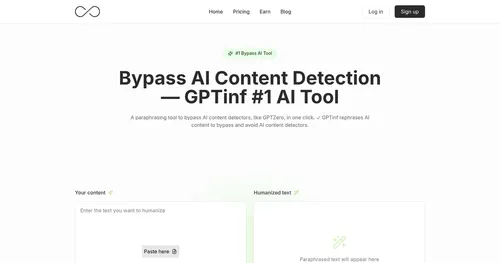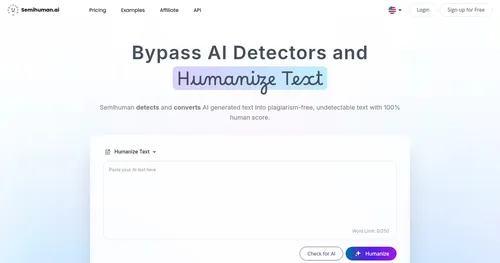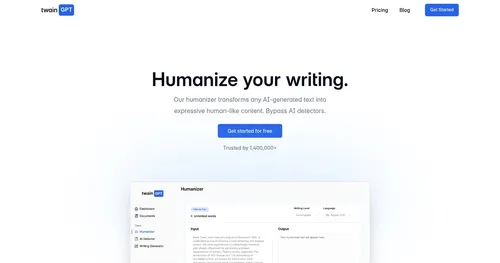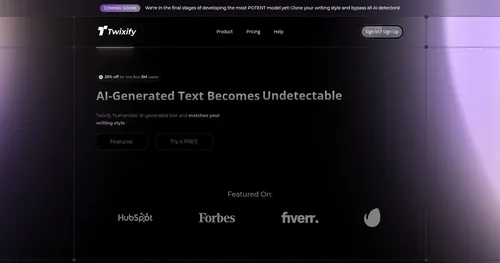OneClickHuman
You’ve got a blog post, spit out by some AI model, and it’s… fine. But it reads like a robot tried too hard to sound human, all stiff phrasing and awkward transitions. Enter OneClickHuman, a nifty tool that promises to take that mechanical text and make it sing like it came from a seasoned writer’s pen. I dove into the world of OneClickHuman, a free AI-to-human content converter that’s got content creators buzzing, and let me tell you, it’s a bit like discovering a shortcut through a creative jungle. This tool doesn’t just tweak your text, it reshapes it into something polished, readable, and — dare I say — charming, all while dodging those pesky AI detectors.
The magic happens with a single click. Paste your AI-generated content into the sleek, no-fuss interface, hit the “Make it Human” button, and watch the transformation unfold. The tool leans on advanced AI models, building on the likes of GPT-2, GPT-3, and GPT-3.5, to refine your text. It’s got three modes — Quality, Balanced, and Wild — each offering a different flavor of humanization. Quality Mode keeps things pristine and professional, perfect for academic papers or corporate blogs. Balanced Mode, the default, strikes a middle ground, enhancing readability while sneaking past AI detection tools like ZeroGPT. Wild Mode? It’s the bold cousin, prioritizing undetectability, though it might loosen up formatting a tad. I found Balanced Mode to be the sweet spot for most tasks, delivering text that feels natural without losing the original structure.
What’s to love? For starters, it’s free. No hidden fees, no subscription traps — just paste, click, and go. The tool preserves your formatting, so your headings, bullet points, and links stay intact, which is a godsend for anyone churning out structured content like blog posts or marketing copy. It’s also a time-saver, turning clunky AI drafts into something you’d proudly publish in minutes. Plus, it’s multilingual, supporting over 10 languages, which makes it a gem for global content creators. SEO folks will appreciate how it optimizes text for search engines, boosting readability scores and engagement metrics, which can nudge your content up Google’s rankings.
But it’s not all sunshine. The free version comes with a daily word limit — 1,500 words per article, 10,500 words during a trial period — which might cramp your style if you’re churning out long-form content. Some users on forums like BlackHatWorld have griped about occasional inconsistencies, especially with shorter texts under 100 words, where the humanization can feel less polished. There’s also a whisper of concern about originality; the process of humanizing might, in rare cases, dilute the unique spark of your original draft. And while the interface is user-friendly, it’s not yet optimized for mobile, so you’re tethered to a desktop for now.
The surprise element? OneClickHuman’s ability to bypass AI detectors is a game-changer for students or freelancers worried about their work being flagged as AI-generated. It’s not perfect — some reviews on Trustpilot raise eyebrows about its ethics — but it works well enough to make your content feel authentic. Compared to competitors like Humanize AI Text or TwainGPT, OneClickHuman stands out for its zero-cost entry and simplicity, though it lacks the advanced customization options of paid tools like Quillbot or Grammarly.
Here’s the practical advice: Start with Balanced Mode for most projects — it’s versatile and reliable. If you’re aiming for SEO, double-check the output for keyword flow, as the tool occasionally smooths out niche terms. For academic work, stick to Quality Mode to keep things formal. And if you’re worried about detection, test your output with tools like GPTZero before submitting. Keep an eye on your daily word limit, and you’ll find OneClickHuman a trusty sidekick for elevating your AI drafts.
What are the key features? ⭐
- Balanced Mode: Enhances readability while preserving formatting and evading AI detection.
- Quality Mode: Delivers polished, formal text ideal for professional or academic use.
- Wild Mode: Prioritizes undetectability, making content pass as human-written.
- Multilingual Support: Processes text in over 10 languages for global usability.
- SEO Optimization: Improves content structure and phrasing for better search engine rankings.
Who is it for? 🤔
Examples of what you can use it for 💭
- Blogger: Converts AI-drafted posts into engaging, human-like content for better reader engagement.
- Marketer: Refines AI-generated ad copy to sound natural and optimize for search engine rankings.
- Student: Transforms AI-written essays into undetectable, polished text for academic submissions.
- Freelancer: Enhances AI-drafted articles to meet client standards for readability and originality.
- Small Business Owner: Improves AI-crafted website content to attract more organic traffic.
Pros & Cons ⚖️
- Free to use with no hidden costs.
- Bypasses AI detectors effectively.
- Boosts SEO with readable text.
- Limited to 1,500 words daily.
- May dilute originality slightly.
FAQs 💬
Related tools ↙️
-
 GPTinf
Create AI-generated content that is undetectable by AI detectors
GPTinf
Create AI-generated content that is undetectable by AI detectors
-
 Semihuman AI
Transform AI-generated content into human-like text that can bypass AI detection systems
Semihuman AI
Transform AI-generated content into human-like text that can bypass AI detection systems
-
Sensity Detects deepfakes in videos, images, and audio with advanced AI technology
-
Decopy AI Detects AI-generated text and transforms it into natural human-like content
-
 TwainGPT
An AI tool that can transform machine-generated text into natural, human-like writing
TwainGPT
An AI tool that can transform machine-generated text into natural, human-like writing
-
 Twixify
An AI-driven tool that transforms AI-generated text into content that mirrors human writing styles
Twixify
An AI-driven tool that transforms AI-generated text into content that mirrors human writing styles

